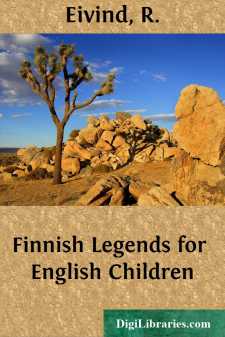Categories
- Antiques & Collectibles 13
- Architecture 36
- Art 48
- Bibles 22
- Biography & Autobiography 813
- Body, Mind & Spirit 142
- Business & Economics 28
- Children's Books 17
- Children's Fiction 14
- Computers 4
- Cooking 94
- Crafts & Hobbies 4
- Drama 346
- Education 46
- Family & Relationships 57
- Fiction 11829
- Games 19
- Gardening 17
- Health & Fitness 34
- History 1377
- House & Home 1
- Humor 147
- Juvenile Fiction 1873
- Juvenile Nonfiction 202
- Language Arts & Disciplines 88
- Law 16
- Literary Collections 686
- Literary Criticism 179
- Mathematics 13
- Medical 41
- Music 40
- Nature 179
- Non-Classifiable 1768
- Performing Arts 7
- Periodicals 1453
- Philosophy 64
- Photography 2
- Poetry 896
- Political Science 203
- Psychology 42
- Reference 154
- Religion 513
- Science 126
- Self-Help 84
- Social Science 81
- Sports & Recreation 34
- Study Aids 3
- Technology & Engineering 59
- Transportation 23
- Travel 463
- True Crime 29
Finnish Legends for English Children
by: R. Eivind
Categories:
Description:
Excerpt
PREFACE
THE following stories cover almost all of the songs of the Kalevala, the epic of the Finnish people. They will lead the English child into a new region in the fairy world, yet one where he will recognise many an old friend in a new form. The very fact that they do open up a new portion of the world of the marvellous, will, it is hoped, render them all the more acceptable, and perhaps, when the child who reads them grows up to manhood, will inspire an actual interest in the race that has composed them.
And this race and their land will repay study, for nowhere will one find a more beautiful land than Finland, nor a braver, truer, and more liberty-loving people than the Finns, although, alas, their love for liberty may soon be reduced to an apparently hopeless longing for a lost ideal. For the iron hand of Russian despotism has already begun to close on Finland with its relentless grasp, and, in spite of former oaths and promises from the Russian Tsars, the future of Finland looks blacker and blacker as time goes on. Yet it is often the unforeseen that happens, and let us trust that this may be so in Finland's case, and that a brighter future may soon dawn, and the dark clouds that now are threatening may be once more dispersed.
·····
In these stories Mr. T. M. Crawford's metrical translation of the Kalevala has been quite closely followed, even to the adoption of his Anglicised, or rather Anglo-Swedish, forms for proper names, though in some instances the original Finnish form has been reverted to. This was done reluctantly, but the actual Finnish forms would seem formidable to children in many instances, and would probably be pronounced even farther from the original than as they are given here. It is to be hoped, moreover, that those who may now read these stories will later on read an actual translation of the Kalevala, and this is an additional reason for adopting the terminology of the only English translation as yet made.
A Finnish newspaper recently states that Mr. C. is now at work on an improved translation.
As this book is only intended for children, it would be out of place to discuss the age, etc., of the Kalevala. Only it would seem proper to state, that while the incantations and some other portions of the text are certainly very old, some of them no doubt dating from a period prior to the separation of the Finns and Hungarians, yet, as Professor Yrjö Koskinen remarks, "The Kalevala in its present state is without doubt the work of the Karelian tribe of Finns, and probably dates from after their arrival in Northern and North-Western Russia." This will of itself largely justify the making Kalevala synonymous with the present Finland, Pohjola with the present Lapland, Karjala with the present Karjala (Anglice, Karelia) in South-Eastern Finland, etc. But even if this were not so, yet the advantage of such localisation in a book for children is of itself obvious.
As the land and people with which the stories are concerned is so unknown to English children, it has seemed best to have some sort of introduction and framework in which to present them, and therefore "Father Mikko" was chosen as the story-teller....


